In addition to a considerable inventory of tools, materials, parts, and old test inventory, we’ve collected a variety of laboratory and field testing equipment. Much of it is of no interest to the average sailor, unless you enjoy testing equipment and exploring rabbit holes, but some is useful or at least entertaining, for those that want to know more about the sailing experience.
We’ve reviewed some of this before, but the cost of electronic testing equipment has plummeted and there are countless new players bringing gadgets to market for a pittance compared to what we paid a decade ago.
Infrared Thermometers
Spot temperature readings can provide major insights into the operation of equipment. Hot spots on a heat exchanger suggests internal clogging. Hot spots in exhaust risers indicate poor mixing. In the winter a scan for cold spots can reveal drafts and gaps in insulation, and in the summer point out the places where solar gain is killing your air conditioning. Snoop your ice box for leaks. Heat flow is approximately proportional to the difference in temperature across any boundary.
Practical Sailor reviewed the devices in 2004 (see “Infrared Thermometers,” PS October 2004). Also the Covid-19 pandemic has spurred the marketing of inexpensive forehead thermometers, most of which have both a “forehead” and surface mode. Our $39 Homedic HTD 8813 agrees with our $350 Fluke 63 within a few tenths of a degree throughout the full range. For four-color thermal images on your phone, the Flir One is now half its original price (see “Gifts for Parents” PS April 2016).
These tools shouldn’t be new to PS readers. We’ve reviewed some of them before, but the cost of electronic testing equipment has plummeted and there are countless new players bringing gadgets to market for a pittance compared to what we paid a mere decade ago.
- Moisture readings near existing hardware or where new hardware will go indicate the state of core.
- A refractometer offers another way to test water quality.
- The refractometer reading looks a lot like the periscope of a submarine. Like any tool, it requires some practice to learn to interpret the readings..
- The Hold Peak 866B isn’t used designed to be used as an anemometer, but we were impresssed by its accuracy, which compared to our shop amemometers.
- Okay, so maybe you don’t need an infrared thermometer to check your favorite dish, but it comes in handy for a wide range of jobs on the boat. We use ours to check engine temperatures, hull insulation values, and leaks in our refrigerator box.
- Our gram scale gets a regular workout during fuel additive testing and other tests that require precise measurements.
- One of the most frequently used tools in our toolbox is the dynamometer, which measures loads. Technical editor Drew Frye used it recently to precisely measure the loads applied this rudder shaft as he tried to bend it back in place.
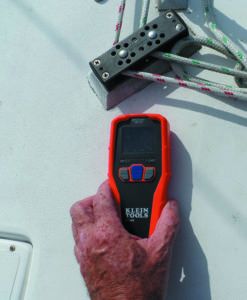
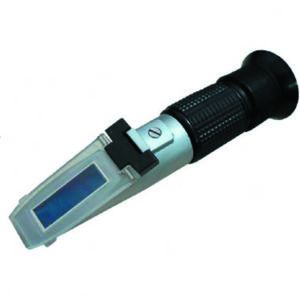



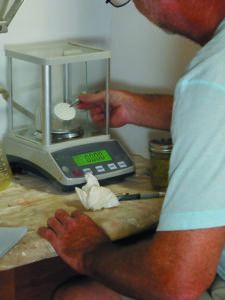
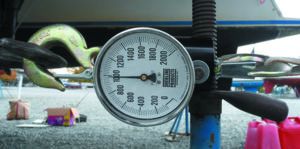
Measuring Mass and Force
We have load and force measuring equipment ranging from 0.1 milligram laboratory balances to 4-ton crane scales, each filling a range of needs.
Lab Scales. We’ve used scales accurate to 0.1 mg when studying corrosion or fuel problems, but a cheap kitchen scale accurate to 0.1 gram is all the sailor will ever need.
Our main use is weighing epoxy before mixing. Having broken countless dispensing pumps, and never having the specific size we need, we learned it was simpler to weigh Part A and Part B, and any additives using disposable cups.
What about the specific gravity correction? Typically the density of Part A and Part B are within a few percent of each other, so a correction is not required, but you can always check the product’s Safety Data Sheet to be certain.
Crane Scales. How much load is on your rode? What is the genoa sheet, spinnaker tack line, or backstay tension? An inexpensive crane scale can be anchored to a hard point and attached to the line in question using a rolling hitch (easy) or Prusik hitch (more secure) and then transferring the load with a winch.
You get what you pay for, but you can do quite well under $100. Don’t bet on it being waterproof.
Analog scales. Based on hydraulic pressure, analog scales are waterproof, more rugged, but slightly less accurate than digital scales. The difference in accuracy doesn’t matter a bit for most applications.
Like most sailors, we purchased our meter to investigate the condition of a cored boat, and specifically to learn more about how far the moisture had travelled from a few fasteners where the bedding had failed. Like a glorified stud finder, the reading is based on capacitance and not direct measurement of water content. Thus, any belief that readings will be accurate is wishful thinking.
Moisture meters don’t read frozen water. Evean hot vs. cold can change readings as much as 5%. Whenever possible, we recommend calibrating with a section of material similar to the deck and core in question.
Perhaps the biggest variable can be reinforcements and changes in layup.Always compare both sides of the boat for symmetry. Samples of never-been-outside laminate from the shop sample stack read 2-16% moisture, depending on thickness, layup, and materials used.
Testing the hull on boats just hauled from the water is highly unreliable and prone to produce false readings. Let it dry for a few weeks. As for the cabin top, recent rain on gel coat has little effect so long as it has dried. Voids and dry core will block readings.
Areas that are wet but that have also delaminated can read relatively dry. Fairing material reads higher than laminate or core. A rotted core that is now dry will read as dry, so you still have to tap and press on the hull and deck to find delamination.
Below 20% moisture rot does not grow. At 30-50%, the core may not feel very wet, but rot will flourish. In solid laminate, high moisture readings deserve further investigation, but aren’t necessarily a death knell.
See review of moisture meters, “Moisture Meters, Can You Trust Them?” Practical Sailor, September 2000.
- Dry fibers cut cleanly.
- Readings on this panel increased from 8 to 30 percent over several days
- This panel is no longer wet, but torn fibers indicate past exposure.
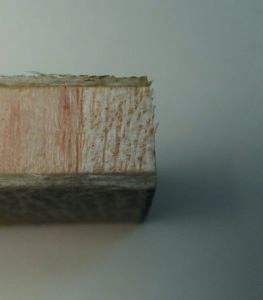

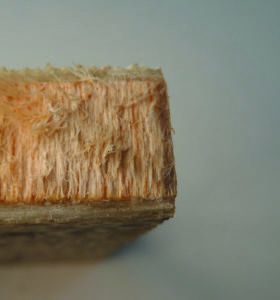
Moisture meters
For reading moisture, we like the pinless Kline ET 140 Pinless Moisture Meter, $40. The meter has settings for drywall, masonry, and hard wood, and uses both a digital readout and a series of lights to display moisture content. Operation seems as simple as installing the battery and sliding it around the deck. But with any meter, check the response vs. your deck type first.
Using the dry wall setting, we tested a section of oven-dried (150F for 2 hours) balsa cored laminate both before (4%) and after two weeks floating in water (36%) using the drywall setting, for a net change of 32%. We also weighed the sample before and after (30.3% change) and concluded that it was accurate for this laminate schedule, which was very similar to our test boat.
Correcting for the probability that the epoxy/glass skins absorbed less water than the core, the calibration was dead on.
Our test sample was ½-inch balsa with 2 x 1708 biaxial cloth laminated with epoxy resin on each side. Other material settings (hardwood) are more appropriate to heavier lay-ups.
Bottom line. A moisture meter is worth the investment if you have a questionable deck to investigate.r
Anemometers
Handheld anemometers have come in handy testing anchor rode and dock line tension for boats that did not have masthead instruments. But we’ve also used it with ventilation product reviews and sailing on the boat to resolve arguments about airflow around sails (see “Handheld Anemometers,” PS August 2000” and “Handheld Weather Stations,” PS July 2002).
When my 1980-vintage handheld anemometer died, I dreaded the cost of replacement. In the midst of COVID-19 lockdown I reached out through Amazon for what I felt sure would be a cheap instrument just sufficient to get me through.
What I got was the Hold Peak 866B, an inexpensive unit that might not stand up to a lot of abuse, but that can read accurately down to a few tenths of a knot. I checked, by walking timed distances in still indoor air, reversing my course to double check. For $25 it’s a great backup for the ship’s instruments if you don’t have a handheld anemometer yet.
Drew Frye is Practical Sailor’s technical editor, he is the author of Modern Anchoring Techniques from Seaworthy Books. He blogs at www.sail-delmarva.blogspot.com.



































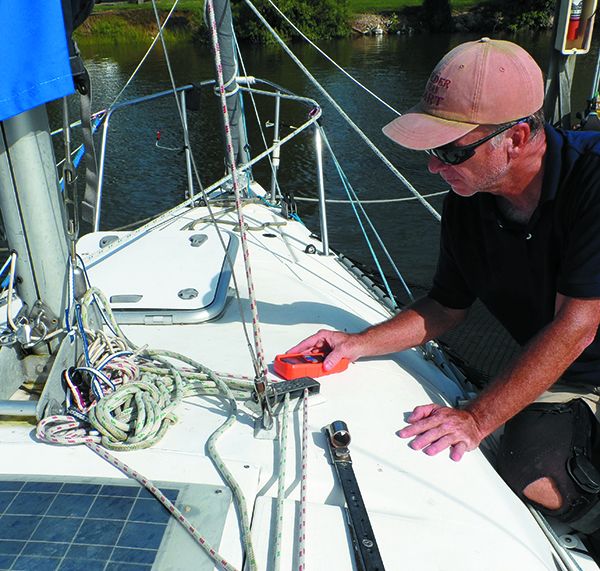





More of a question than a comment , My main sheet traveler track is set up in the back of my sail boat , i would like to move to front of my cockpit bach of the mast . what is the minimum distance to observe , to install on the boom from the mast to the end of the boom (center of the boom to end of boom.)
Can it be done and is it a good idea.
Thanks in advance.
SV Savannah (Hullmaster27)
“Handheld anemometers have come in handy testing anchor rode and dock line tension for boats that did not have masthead instruments.”
This magazine is no longer a quality product of yesteryear as evidenced by lots of careless misspellings and nonsense text, such as the example above.
That is why I no longer subscribe.
This sentence makes sense to me Marc, have you not wondered how tension on your rode relates to wind speed?
Although my reaction was different, and my doubts less certain, I wondered about (read as hoped for) an explanation for the use of a handled anemometer in testing anchor rode and dock line tension. Despite subsequent ideas about possibilities, I still hope explanations will be forthcoming.
With homage to the wonders of computers and word processors, old fashioned editing still works wonders -depending upon the editor’s knowledge, and if time and economics permit.
I continue to subscribe.
Rode tension and dock line tension vary according to wind speed (roughly with V^2). Tension, of course, is measured with a hanging scale or load cell, but without knowing the wind speed and wave exposure during each measurement, the tension number would be meaningless. When testing our own boats, we would use instruments located at the top of the mast, but when taking measurements of dockline tension on neighboring boats (more data is always better!) or rode tension on boats without instruments, that information was not available, so we used a handheld meter (adjusted for the typical difference between ground level and top-of-mast wind speed).
For example, this July, 2014 article on dockline tension. https://www.practical-sailor.com/safety-seamanship/fenders-and-lines-for-seawalls
I hope that is more clear.
A serious challenge and unpleasant reality for publications, such as Practical Sailor, that do not accept advertising, is the cost of paper. Articles are brutally cut for length, often at the expense of clarifying sentences. If you ever have questions… ask them! More than the big glossy ad-driven publications, we strive to respond to every question, including the most individual sailing problem. Often these inquiries lead directly to research and articles, such as an up-coming article on nylon rope, which explores permanent elongation with overload and fatigue. A reader asked if a certain amount of stretch in a snubber after a storm meant that it was shot, even though it still looked fine. We researched it, tested it, and concluded that he was correct; you can infer if a nylon snubber has been overloaded by how much it has become permanently stretched.
And yes, my spelling is terrible:).
Maybe it isn’t a diagnostic tool, but my digital calipers are indispensable. I don’t work with nuts, bolts, tubing, and line size frequently enough to hold one between my fingers and know what size I have. I love my digital calipers even if 1/128’ths are too precise for me.
For the more geeky…… with an esp32 & old kitchen scale you should be able to make a rope tension meter, add a raspberry Pi & the data can be written once a second to a database for graphing, if the wind data goes to the raspberry then plot the wind & rode tension. I’ve only got as far as weighing coins accurately so far but shoud be just a little fabrication & calibration, had to guess how accurate but it should certainly show trends & load spikes. IMHO anyone just a little interested in data should be recording it for plotting, signalk on a raspberry pi/laptop can do all that, fascinating 😎
“had to guess” should be hard to guess.. can you edit posts? ta
If the boat were anchored in a fully protected harbor (fetch no more than 100 feet), with zero yawing and zero gust variation, you could show a plot of wind vs. rode tension. Once you add yawing, waves, and gusts, the range of tension can be as high as 400% and curves rather nonsensical. We report only the maximums, which occur when yawing, the bow rising to waves, gusts, and the rode coming tight all coincide. This generally takes 10-20 minutes of observation, and still, a higher maximum is possible every few hours, when everything coincides just so, but by then the windspeed and wave direction may well have changed. It’s complicated.
one thing I’ve learned from somewhat obsessive plotting of data, masses of detail gets missed if just looking at the numbers on a display, there will be slow trends & things going on you just won’t otherwise know about. Really is like looking through a keyhole compared to opening the door and turning on the light.. 😎 Plus costs little, when I get round to getting a basic rope tension meter rigged up I’ll post the details somewhere. Signalk does all the work for you.